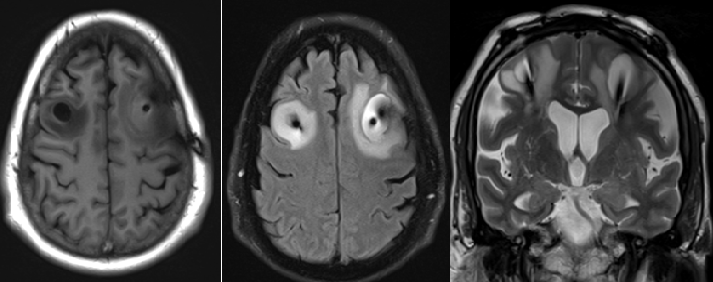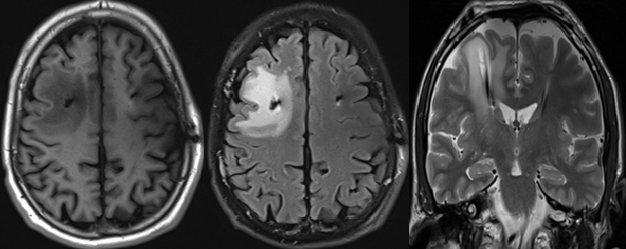Session Information
Date: Wednesday, September 25, 2019
Session Title: Surgical Therapy
Session Time: 1:15pm-2:45pm
Location: Les Muses Terrace, Level 3
Objective: To present two case report
Background: Deep brain stimulation (DBS) is an effective surgical therapy for certain neurological and psychiatric disorders, but it is not free of complications. Late-onset idiopathic cerebral edema, located around the electrodes, is an infrequent complication. Its etiology, predisposing factors and prognosis is unknown.
Method: Case 1A 67-year-old male with incapacitating essential tremor (ET) underwent surgery for DBS in the VIM. The procedure proceeded smoothly, only a mild pneumocephalus was visualized. Monopolar omnidirectional stimulation was programmed in both electrodes with standard parameters. The patient presented good evolution, being discharged 72 hours after surgery. Two days later he began with drowsiness, headache and dysarthria. CT showed vasogenic edema around the path of both electrodes and treatment with dexamethasone and antibiotherapy was prescribed. A MRI (Fig. 1), confirmed the CT findings. Ten days later the neuroimaging study showed a decrease in edema suggesting an inflammatory process. Afterwards the symptoms progressively improved, disappearing 5 weeks after surgery.Case 2: A 59-year-old male with incapacitating TE underwent bilateral DBS in the VIM. The procedure was performed without any incident. Omnidirectional stimulation was programmed with standard parameters and CT showed a minimum bifrontal pneumocephalus. One week later, the patient began with drowsiness and dysarthria, the CT revealed edema around the right electrode, interpreted as a possible abscess, and antibiotherapy was administered. Fifteen days after surgery an MRI confirmed the existence of non-capturing vasogenic edema and discarding the infectious etiology (Fig.2). He recovered completely and 6 months later a CT confirmed the disappearance of the edema.
Results: Discussion In recent years, several cases of late onset edema associated with DBS have been reported. This entity has been defined as edema surrounding the electrodes, which begins more than 72 hours after the intervention, in the absence of trauma, vascular events or infection. The estimated incidence is 6.3% and may be accompanied by other neurological symptoms. MRI usually confirms the presence of edema surrounding the electrode and ruled out other complications.
Conclusion: The etiopathogenic mechanism of late onset idiopathic cerebral edema is unknown.
References: 1. Dietrich Haubenberger, M.H.Sc., M.D., Mark Hallett, M.D., D.M. Essential Tremor. N Engl J Med 2018; 378:1802-1810 . (DOI: 10.1056/NEJMcp1707928) 2. Groppa S, Herzog J, Falk D, Riedel C, Deuschl G, Volkmann J. Physiological and anatomical decomposition of subthalamic neurostimulation effects in essential tremor. Brain, volume 137, 2014, 109–121. 3. de Cuba CM, Albanese A, Antonini A, Cossu G , Deuschl G , Eleopra R et al, Idiopathic delayed-onset edema surrounding deep brain stimulation leads: Insights from a case series and systematic literature review, Parkinsonism and Related Disorders, 2016 Nov;32:108-115. (http://dx.doi.org/10.1016/j.parkreldis.2016.09.007) 4. T. A. Zesiewicz, R. Elble, E. D. Louis, et al. Practice Parameter: Therapies for essential tremor. Report of the Quality Standards Subcommittee of the American Academy of Neurology. Neurology. 2005;64;2008-2020. 5. Tong F, Ramirez-Zamora A, Gee L, Pilitsis J. Unusual complications of deep brain stimulation. Neurosurg Rev. 2015 Apr;38(2):245-252; (doi: 10.1007/s10143-014-0588-9. Epub 2014 Oct 25) 6. Englot DJ, Glastonbury CM, Larson PS. Abnormal T 2 -Weighted MRI Signal Surrounding Leads in a Subset of Deep Brain Stimulation Patients. Stereotact Funct Neurosurg. 2011;89(5):311-317. (10.1159/000329365)
To cite this abstract in AMA style:
M. Blázquez Estrada, P. Siso García, E. Suárez Sanmartín, J. Sol Alvarez, E. Santamarta Liébana, C. García Fernández, B. Lozano Aragoneses, J. Alvarez Carriles, A. Sáiz Ayala. Late onset idiopathic cerebral edema associated with deep brain stimulation [abstract]. Mov Disord. 2019; 34 (suppl 2). https://www.mdsabstracts.org/abstract/late-onset-idiopathic-cerebral-edema-associated-with-deep-brain-stimulation/. Accessed April 1, 2025.« Back to 2019 International Congress
MDS Abstracts - https://www.mdsabstracts.org/abstract/late-onset-idiopathic-cerebral-edema-associated-with-deep-brain-stimulation/


